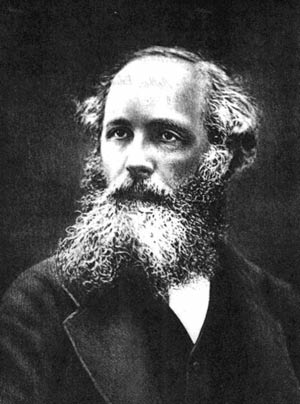James Maxwell was one of the world’s most influential physics. In particular, he made great strides in helping to understand electro-magnetism, and produced a unified model of electro-magnetism. His research in kinetics and electricity laid the foundations for modern Quantum mechanics and special relativity.
“The work of James Clerk Maxwell changed the world forever.”
– Albert Einstein
Short Bio James Maxwell
 James Clerk Maxwell (13 June 1831 – 5 November 1879)
James Clerk Maxwell (13 June 1831 – 5 November 1879)
James was born in Edinburgh, Scotland in 1831.From his early childhood, he displayed a natural inquisitiveness, always asking how things worked and moved as they did.
When he was eight, his mother died, and his father John took responsibility for his upbringing along with his sister-in-law Jane. In 1841, he went to the Edinburgh Academy. He was a satisfactory student, but took great interest in subjects outside the school syllabus, especially geometry, drawing and maths. At the age of 14, he wrote his first scientific paper (Oval Curves)
In 1847, he moved to the University of Edinburgh where he studied classes on logic, mathematics, and natural philosophy. However, like at school, he was more interested in pursuing his own studies outside the curriculum. He investigated the properties of polarized light and prisms, and importantly made his early investigations into electric and magnetic equipment. Aged 18, he presented another two scientific paper – though as he was considered too young, it was delivered to the Royal Society by his tutor Kelland instead.
In 1850, he moved to Trinity College, Cambridge, and studied mathematics under the great tutor – William Hopkins. Maxwell, graduated with a top degree in mathematics, and was able to pursue his own research interests. At the time, this included investigating the properties of colour. He delivered his first lecture to the Royal Society Of Edinburgh in March 1855 on his Experiments on Colour. In the same year, he was made a fellow of Trinity. But, shortly after, in 1856, an opportunity arose to take the Chair of Natural Philosophy at Marischal College, Aberdeen and he applied and took it. He married Katherine Mary Dewar in 1857.
At Aberdeen he spent part of his time lecturing and marking exam papers, but he still had the opportunity to pursue other areas of research. He was able to display his considerable talent, by providing a theoretical explanation for Saturn’s Rings, it also earned him £130 and the Adams Prize from St John’s College, Cambridge.
In 1860, he suffered a serious bout of smallpox, but survived and moved to Kings College, London. In his time in London, he became acquainted with Michael Faraday at the Royal Institute and made great progress on his work in electro-magnetism, including a model for electromagnetic induction. In one of his most important works, he wrote:
This velocity is so nearly that of light, that it seems we have strong reason to conclude that light itself (including radiant heat, and other radiations if any) is an electromagnetic disturbance in the form of waves propagated through the electromagnetic field according to electromagnetic laws. A Dynamical Theory of the Electromagnetic Field (1864), §20.
In 1865, he returned to Glenair in Scotland and wrote a book Theory of Heat (1871)
In 1871, he moved back to Cambridge, working on the development of the Cavendish laboratory.
He died in of abdominal cancer on 5 November 1879 at the age of only 48 .
He died in of abdominal cancer on 5 November 1879 at the age of only 48 .
James Maxwell was a real polymath. As well as his scientific discoveries, he loved poetry and enjoyed drawing. Though many contemporaries mentioned he lacked grace and confidence in social situations. He gained reputation as a typical eccentric scientist. He was also an evangelical Christian. He wrote on the link between science and Christianity
I think men of science as well as other men need to learn from Christ, and I think Christians whose minds are scientific are bound to study science that their view of the glory of God may be as extensive as their being is capable. But I think that the results which each man arrives at in his attempts to harmonize his science with his Christianity ought not to be regarded as having any significance except to the man himself, and to him only for a time, and should not receive the stamp of a society. (Draft of a reply to an invitation to join the Victoria Institute (1875), in Ch. 12 : Cambridge 1871 To 1879, p. 404)
James Maxwell Scientific Achievements
Maxwell’s equations have had a greater impact on human history than any ten presidents.
– Carl Sagan
Maxwell’s greatest contribution to science included:
- The observation electromagnetic fields travel at speed of light showing the connection between light and electro magnetism.
- Prediction of waves and oscillating electric and magnetic fields
- Writing equations for electromagnetism. Later known as Maxwell’s equations.
- The concept of the electromagnetic field, which was later worked on by Albert
- Einstein, leading to his theory of special relativity.
- His work on optics and colour, laid foundations for practical colour photography.
- He also helped explain the phenomena of colour blindness
- He developed Kinetic theory for gases – Called Maxwell distribution.
- Work on thermodynamics
- Control theory relating to centrifugal governor used in steam engines.
James Maxwell is considered by many to be the one of the three greatest ever scientists. On par with Isaac Newton and Albert Einstein.
Einstein himself once described Maxwell’s work as the:
“most profound and the most fruitful that physics has experienced since the time of Newton.”
Einstein said he had a photograph of Maxwell, Michael Faraday and Newton in his study.



No comments:
Post a Comment